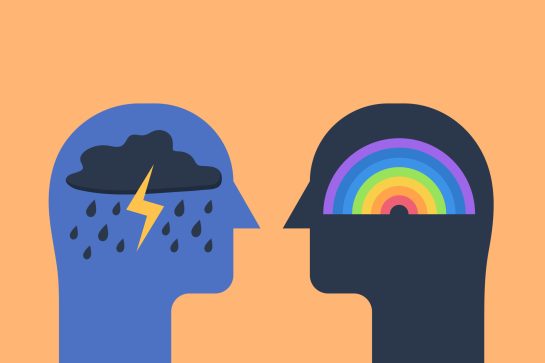With World Mental Health Day coming up on October 10th, communities across the globe are looking for better ways to manage mental and behavioral health. Social determinants of health are an effective way of measuring these mental health levels, and research suggests that mental health may have a cyclical relationship with these indicators: SDoH can often predict mental illness, and likewise these untreated issues can be a precursor to lower levels of SDoH. Programs can best help at-risk individuals by taking a comprehensive approach.
THE STATE OF MENTAL HEALTH IN THE US
Did you know that mental health issues—and the behavioral problems that are associated—account for over 1/3 of all disease in the United States1? Approximately 50% of all US citizens will experience a mental health issue in their lifetime, with more than 1/5 of adults working through a diagnosable mental health condition in a given year.
It is no question that the status of mental health in the US is in crisis. It is nearly double the rate of other developed countries2. Although mental health is prevalent across all nations, not all populations are affected equally.
WHO IS AT RISK, AND WHY?
Disadvantaged communities continuously show the highest number of mental illness cases. For instance, 1/4 of the total homeless population experiences some form of severe mental illness3. Substance abuse (like alcoholism and drug addiction) stemming from mental health is 20-30% higher in LGBTQ individuals than heterosexual and cis-gender people. Even more, some reports indicate up to 80% of refugees face depression and anxiety in the US4.
There is a reason why mental illness is so common among these populations. Disadvantaged communities often face the greatest difficulties among social determinants of health (SDoH). These determinants inform not only the risk of disorder, but also the access to mental services which in turn affect improved outcomes.
Specifically, researchers have found that a large number of SDoH directly correlate with individual and community mental health5. These factors include, but are not limited to:
- Employment status and workplace hostility
- Socioeconomic status
- Poor housing conditions
- Food insecurity and poor diet
- Discrimination for sexual orientation, gender identity, and race/ethnicity
- Lack of family support
- Community factors such as urbanicity and safety
- Police brutality in neighborhoods
- Fixed characteristics like gender, age, and nationality
When populations experience these hardships, they become increasingly at-risk for mental disorders. However, the relationship is not one-way; there is also a converse pathway between mental health and SDoH.
A TWO-WAY RELATIONSHIP
Mental illness is also likely to impact and even change SDoH6. For instance, mental health has a trend of common difficulties including:
- Homelessness
- School dropout (both high school and high education)
- Marital instability, often leading to domestic violence
- Economic insecurity
- STD risk
The cycle is often brutal and steep, with SDoH feeding mental disorders, then mental illness creating more SDoH disparity, and so forth. Mental health affects all areas of social issues, including homelessness, food security, crime rates, refugee resettlement, and addition recovery, just to name a few.
Quite simply, health and mental health are interdependent; you cannot expect to improve a community’s health without also improving mental health, or vice versa.
ADDRESSING BOTH SDoH AND MENTAL HEALTH
Despite the current challenges that face mental health in the US, many programs are finding success in approaching such issues through an interdependent lens.
For example, several US programs found that when emphasis was placed on improving refugee mental health, such interventions found a substantial increase in refugee health confidence, health-seeking behavior, English proficiency, quality of life, and level of enculturation7. In turn, as these SDoH improved for the refugees, they reported improved mental health as well.
Just as the two-way relationship can send vulnerable people down a deep spiral, they can also work together to strengthen and reinforce one another.
THE FUTURE OF MENTAL HEALTH INTERVENTIONS
As social programs continue to use SDoH to inform mental health (and conversely measuring mental health to improve SDoH), they can expect to see an increase in effectiveness. Importantly, doing so is a lot easier than expected. The Hogg Foundation for Mental Health provides three things to keep in mind8 as governments, social programs, and non-profits work towards incorporating both mental health and SDoH into initiatives. They state the following:
- Social determinants have complex impacts on health and mental health. People experience better outcomes when providers—and community leaders—use social determinant interventions.
- Protective factors are as important to consider as risk factors.
- The impact of a social determinant might not be immediate but reveal itself over time or in crisis.
Overall, it is important to remember that mental health and SDoH go hand-in-hand. As we work to improve both of them, entire communities can be lifted to a better quality of life.
SOURCES
- https://www.apha.org/policies-and-advocacy/public-health-policy-statements/policy-database/2015/01/28/14/58/support-for-social-determinants-of-behavioral-health
- https://www.apha.org/policies-and-advocacy/public-health-policy-statements/policy-database/2015/01/28/14/58/support-for-social-determinants-of-behavioral-health
- https://www.apha.org/policies-and-advocacy/public-health-policy-statements/policy-database/2015/01/28/14/58/support-for-social-determinants-of-behavioral-health
- https://www.ncbi.nlm.nih.gov/pmc/articles/PMC6181118
- https://www.tandfonline.com/doi/abs/10.1080/01612840.2019.1669748?journalCode=imhn20
- https://hogg.utexas.edu/3-things-to-know-social-determinants-of-mental-health



